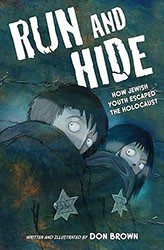How do you explain the Holocaust to a child, and at what age is any explanation appropriate? These are questions long debated, and there will probably never be agreement on the answers. Hidden, a short, graphic novel, is pitched to the grade school audience, and for those who’ve decided their child should be introduced to this dark period of history, this book is a very good place to start. The book opens late one night with a little girl happening upon her grandmother, Dounia, who is inexplicably crying. The little girl advises her to talk about it — that’s what she does when she has a nightmare — and so begins the grandmother’s recollections of her life in France as a child during the German occupation. The author and artist manage
to cover an extremely difficult subject with real sensitivity, neither glossing nor making it too difficult for a grade-schooler to un- derstand. For example, in order not to scare her, Dounia’s father tells her that the Jewish stars the family must wear now are sheriff’s stars (a notion she is excited by, then quickly disabused of by a similarly-situated school pal). The narrative continues on through the end of the war, when Dounia, who has been hidden by quietly heroic neighbors, is reunited with her mother (unhappily, her father does not survive). The ending — which returns to present times — seems not as carefully crafted as the rest of the book, but overall, Hidden is a poignant and powerful story, a sort of Maus for the younger set.
Recommended for ages 7 – 10.





